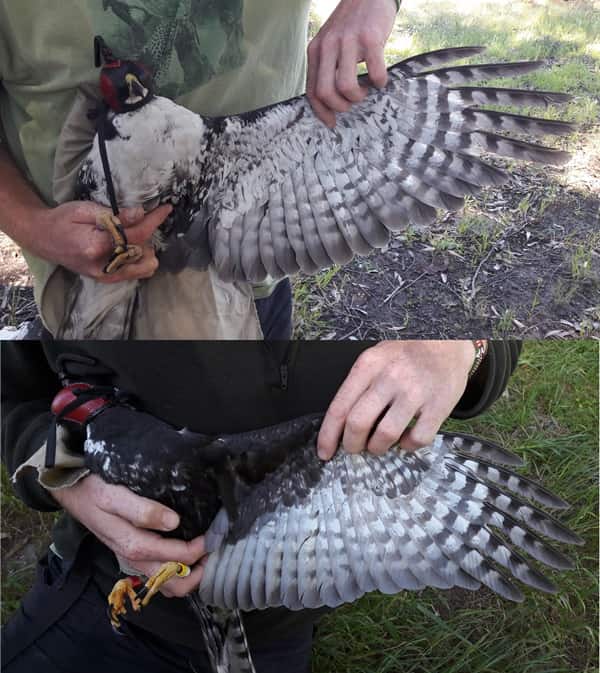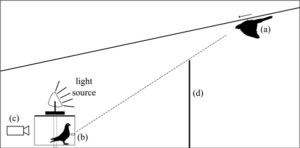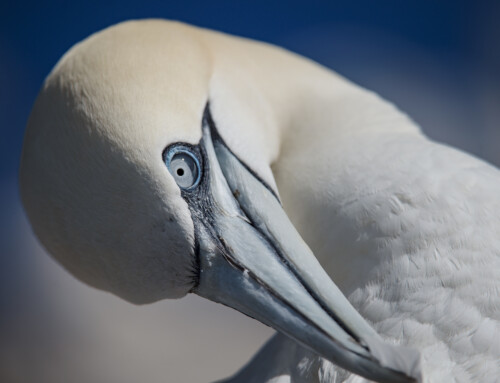LINKED PAPER
Response time of an avian prey to a simulated hawk attack is slower in darker conditions, but is independent of hawk colour morph. Nebel, C., Sumasgutner, P., Pajot, A., Amar, A. 2019. Royal Society Open Science. DOI: 10.1098/rsos.190677. VIEW
Predation is a strong evolutionary force that will shape the behaviour of both prey and predators. In nature, predation risk will vary depending on the environment, in a spatial but also temporal context, and prey will avoid whereas a predator will exploit areas or times of the day when prey is especially easy to catch. An additional component determining predation risk or foraging success is added when the predatory species is colour polymorphic: Differently coloured predators can be easier or harder to spot depending on environmental conditions. For example, white Barn Owls, Tyto alba, have a higher foraging success in moon-lit nights (San-Jose et al. 2019) and dark Red-tailed Hawks, Buteo jamaicensis, are more difficult to see when they are perched in more densely vegetated areas (Preston 1980).
 Figure 1 The two morphs of the colour polymorphic Black Sparrowhawk, Accipiter melanoleucus. The light morph, shown on the top, is predominantly white on the breast, belly and underwing coverts, whereas the dark morph (bottom photo) is almost completely melanistic in these plumage parts. Within the morphs there is variation of the expression of black and white feathers, but the two morphs are considered as distinct
Figure 1 The two morphs of the colour polymorphic Black Sparrowhawk, Accipiter melanoleucus. The light morph, shown on the top, is predominantly white on the breast, belly and underwing coverts, whereas the dark morph (bottom photo) is almost completely melanistic in these plumage parts. Within the morphs there is variation of the expression of black and white feathers, but the two morphs are considered as distinct
The Black Sparrowhawk, Accipiter melanoleucus, is a colour polymorphic Accipiter hawk and occurs in two colour morphs: a dark and a light one (Fig. 1). Previous research has shown that dark morphs forage more and deliver more prey items when there is dark or overcast weather whereas light morphs forage independently of ambient light but deliver more when it is bright (Tate and Amar 2017; Tate et al. 2016). These observations lead us to the hypothesis that foraging success must be linked to different light levels, with dark morphs having a higher foraging success under low-light and light morphs under bright conditions.
An experiment should help question this hypothesis
A pulley experiment was set up that allowed to control ambient light and background conditions. A taxidermy mounted Black Sparrowhawk was “flown” at a feeding Feral Pigeon, Columba livia domestica, and its response to this predatory attack was recorded by a high-speed camera (Fig. 2 and Video). For our hypothesis to be accepted, we would predict that Feral Pigeons would react slowest to a dark morph under low light levels and to a light morph under bright light levels. Slower reaction times would result in higher predation rates in nature, the pigeon would thus be an easy snack.

Figure 2 A line was spanned across the room with a taxidermy mounted Black Sparrowhawk (a) attached. It slid down this line, towards a feeding Feral Pigeon in a cage (b), in an attacking fashion. A high-speed camera (c) was placed behind the cage to record the point of first visibility of the hawk – standardised by a blind (d) – and the pigeon’s initiation of an escape response. A light source was placed on top of the cage
Video The experiment in action
Pigeons react depending on light levels
Our results show a clear pattern: Feral Pigeons react slowest under low light levels, but independently of the morph of the hawk. They did not react slower to a dark morph than to a light morph under low light conditions; thus, the main hypothesis of our experiment had to be rejected.
The slow reaction time of Feral Pigeons under low light levels makes sense if we think of how birds behave in nature: They avoid risky behaviours, i.e. foraging, as long as it is not sufficiently light and most song birds engage in less risky behaviours, i.e. singing during the early hours of the morning and the evening.
What do the results mean for the Black Sparrowhawk system?
To summarise our previous and new findings, dark morph Black Sparrowhawks bring more food to the nest during low light conditions, however, they also hunt more during this time. This higher foraging effort might be the reason for more food being delivered to the nest. Contrary, light morphs deliver more food when it is bright and sunny, but they do not forage more. We would expect a foraging success here, but this our experiment failed to find.
Our experiment has pushed us to question our idea of a crypsis advantage that is morph- and ambient light-dependent: What if the higher foraging effort of dark morphs does not result in a higher foraging success? It might be that dark morphs have to increase their foraging effort, because they are – just like the Feral Pigeons in our experiment – bad foragers under low light conditions. The question remains why dark morph black sparrowhawks hunt under these conditions if they are not ideal for them.
Of course, our experiment is highly artificial resulting in drawbacks. For example, the position of the light is unnatural, but was chosen to light up the hawk from below to make the two morphs easy to distinguish to the pigeon. Furthermore, light levels used were limited by the low-light capabilities of the high-speed camera and the heat production by the lamps. It might be that this experiment produces completely different results under natural conditions.
Nominate this article for a BOU Science Communication Award.
References
Preston, C.R. 1980. Differential perch site selection by color morphs of the red-tailed hawk (Buteo jamaicensis). The Auk 97(4): 782-789. VIEW
San-Jose, L.M., Séchaud, R., Schalcher, K., Judes, C., Questiaux, A., Oliveira-Xavier, A., Gémard, C., Almasi, B., Béziers, P., Kelber, A., Amar, A. & Roulin, A. 2019. Differential fitness effects of moonlight on plumage colour morphs in barn owls. Nature Ecology and Evolution 3: 1331–1340. VIEW
Tate, G.J. & Amar, A. 2017. Morph specific foraging behavior by a polymorphic raptor under variable light conditions. Sci Rep. 7(1): 9161. VIEW
Tate, G.J., Bishop, J.M. & Amar, A. 2016. Differential foraging success across a light level spectrum explains the maintenance and spatial structure of colour morphs in a polymorphic bird. Ecol Lett. 19(6): 679-686. VIEW
Image credit
Featured image: Black Sparrowhawk, Accipiter melanoleucus © Black Sparrowhawk Project





